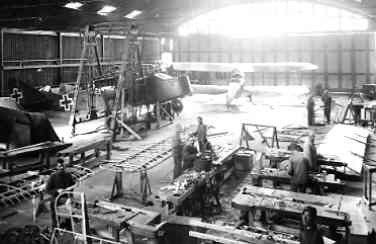History
The forerunner of the G. III was a successful bomber in 1917 was succeeded by the Friedrichshafen G. III (factory designation FF.45).
It was taller and had a larger wingspan than its predecessor.
G. II tended to head stand when landing; at
the G III, this was compensated by adding a nose wheel.
Furthermore the G.II had two more powerful Mercedes D.IVa engines of 260 horsepower each, so a bomb load of 1000 kg could be carried.
Versions.
- Friedrichshafen G. IIIa:
- had a modified wing, which improved handling in flight on one engine. Furthermore, a third machine gun was added for defence against night fighters.
- Friedrichshafen G. IIIb:
- was a further modified version, the rear gunner having now a connection with the rest of the crew.
After the war, various G.IIIs were adapted and used as passenger aircraft.
| Dimensions: | |||
| Length: | 7,15 m | Wing span: | 13,46 m |
| Height: | 3,35 m | Wing surface: | 39 m2 |
| Weigths: | |||
| Empty weight: | 802 kg | Full Weight: | 1120 kg |
| Performance: | |||
| Max. speed: | 158 km/hr | Rate of climb: | - m/min |
| Reach: | 450 km | Service level: | 5000 m |
| Miscellaneous: | |||
| Engine: | One 160 pk Mercedes D.III | ||
| Crew: | One pilot plus one observer/air gunner | ||
| Armament: | One fixed Spandau LMG-08/15 machine-gun plus one rotating Parabellum MG-14 machine-gun. A bomb-load of 100 kb max. | ||
This three seat bomber from Bombengeschwader II made a forced landing on May 23, 1918 near Oosterhout. The German crew consisted ofLt. F.J.H. Vogel (Beobachter), Vzfw. P. Schneider and Uffz. J. Dellinger
The aircraft had still a 300 kg bomb on board, which was dismantled and removed. It entered Dutch service with the serial FG702 and at that time the largest aircraft in the inventory of the LVA.
However the LVA never flew with this large aircraft.

[Enclosed photo from BeeldBank NIMH. Click on photo for ordering information]

[Enclosed photo from BeeldBank NIMH. Click on photo for ordering information]
| Serial | German Werknr. | German Bestellnr. | Date in service | Date out of service | Notes |
|---|---|---|---|---|---|
| FG-702 | 828/17 | 23-05-1918 |
1/72nd Scale
Kits
- Lüdemann
- Kit XX: a resin kit of Friedrichshafen GIIIa kastenleitwerk.
- Kit XX: a resin kit of Friedrichshafen GIII.
- Chorozy Model
- Kit MKC001: Friedrichshafen GIIIa (Polish Version).
- Formaplane
- Kit F2: a vacu formed kit.
Modelling add-on
- --
- Set --: --.
Decals
- --
- Set --: --
1/48th Scale
Kits
- --span>
- Kit --: --
Modelling add-on
- --
- Set --: --.
Decals
- --
- Set --: --
The Friedrichshafen had the German camouflage colours used at that time, possibly the fuselage was dark green with german purple and the wings had a lozenge pattern.
| Scheme | Colour name | FS number | BS-number | Humbrol | XtraColor | Vallejo Model Color | Vallejo Model Air | |
|---|---|---|---|---|---|---|---|---|
Check www.paint4models.com for an extensive conversion table with lots of colour and paint systems.
Literature.
| Nederlandse Militaire Luchtvaart in Beeld. deel 1. | Hugo Hooftman | Pag. 40 - 41 | 1977 | Uitgever: Europese Bibliotheek, Zaltbommel |
| KLu Vliegtuigen: De vliegtuigen van de Koninklijke Luchtmacht vanaf 1913 | Wim Schoenmaker & Thijs Postma | Pag. 15 | 1987 | Uitgeverij De Alk, Alkmaar |
| Vintage Aviation fotofax German Bombers of World War One | Alex Imrie | Pag. 51 - 62 | 1990 | Uitgever: Arms and Armour Press, Poole, Dorset |
| Squadrons van de Koninklijke Luchtmacht (derde herzien druk) | Willem Helfferich | Pag. 14 - | 1994 | Uitgevers Wyt, Rotterdam |
| Camouflage en Kentekens | J.Greuter e.a. | 1997 | Bonneville – Bergen (NH) | |
| Air Enthusiast no.80 The Historical Aviation Journal: Unexpected Windfalls | Bart van der Klaauw | Pag. 54 - 59 | 1999 | Uitgever: Key Publishing, Stamford |
Websites.
 Nederlands (nl-NL)
Nederlands (nl-NL)  English (United Kingdom)
English (United Kingdom)